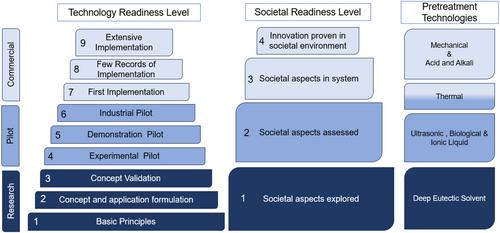下载PDF
{"title":"用于厌氧消化的纺织废物预处理:综述和技术可行性研究","authors":"Naveenrajah Tharmarajah, Kaveh Shahbaz, Saeid Baroutian","doi":"10.1002/jctb.7728","DOIUrl":null,"url":null,"abstract":"<p>The increasing volume of textile waste in landfills and incineration poses severe environmental challenges. Waste valorisation of textile waste via anaerobic digestion (AD) is preferable, as it offers economic and environmental benefits, but it is hindered by textile complexity, necessitating effective pretreatment technologies to improve biogas production. This study aims to evaluate various pretreatment technologies for biogas production from textile fibres via AD. A weighted-scoring analysis (WSA) assessed pretreatment methods based on technical, economic, environmental and operational criteria. Hydrothermal pretreatment emerged as the most technically effective method, scoring 140 owing to its substantial methane enhancement. Economically, shredding was the most viable option, scoring 125, as a consequence of low capital and O&M cost. Environmentally, hydrothermal and deep eutectic solvent (DES) pretreatments were top performers with 100 points owing to low environmental impact and positive heat reactions. In a case study conducted in the Auckland region, the potential environmental impact (PEI) obtained from hydrothermal and DES were 169 and 92 per year, respectively, resulting in minimal environmental impact. Operationally, ultrasonic and biological pretreatments scored highest owing to their ease of operation, and minimal health and safety requirements. Overall, hydrothermal pretreatment achieved the highest WSA score of 340, reflecting its balanced performance across all criteria. Hydrothermal pretreatment is the most promising technology for enhancing biogas production from textile waste. Its technical efficiency, economic feasibility and environmental benefits regarding the WSA score make it suitable for upscaling and providing a viable solution for managing textile waste in the AD plant. © 2024 The Author(s). <i>Journal of Chemical Technology and Biotechnology</i> published by John Wiley & Sons Ltd on behalf of Society of Chemical Industry (SCI).</p>","PeriodicalId":15335,"journal":{"name":"Journal of chemical technology and biotechnology","volume":"99 11","pages":"2213-2227"},"PeriodicalIF":2.8000,"publicationDate":"2024-08-21","publicationTypes":"Journal Article","fieldsOfStudy":null,"isOpenAccess":false,"openAccessPdf":"https://onlinelibrary.wiley.com/doi/epdf/10.1002/jctb.7728","citationCount":"0","resultStr":"{\"title\":\"Textile waste pretreatment for anaerobic digestion: a review and technology feasibility study\",\"authors\":\"Naveenrajah Tharmarajah, Kaveh Shahbaz, Saeid Baroutian\",\"doi\":\"10.1002/jctb.7728\",\"DOIUrl\":null,\"url\":null,\"abstract\":\"<p>The increasing volume of textile waste in landfills and incineration poses severe environmental challenges. Waste valorisation of textile waste via anaerobic digestion (AD) is preferable, as it offers economic and environmental benefits, but it is hindered by textile complexity, necessitating effective pretreatment technologies to improve biogas production. This study aims to evaluate various pretreatment technologies for biogas production from textile fibres via AD. A weighted-scoring analysis (WSA) assessed pretreatment methods based on technical, economic, environmental and operational criteria. Hydrothermal pretreatment emerged as the most technically effective method, scoring 140 owing to its substantial methane enhancement. Economically, shredding was the most viable option, scoring 125, as a consequence of low capital and O&M cost. Environmentally, hydrothermal and deep eutectic solvent (DES) pretreatments were top performers with 100 points owing to low environmental impact and positive heat reactions. In a case study conducted in the Auckland region, the potential environmental impact (PEI) obtained from hydrothermal and DES were 169 and 92 per year, respectively, resulting in minimal environmental impact. Operationally, ultrasonic and biological pretreatments scored highest owing to their ease of operation, and minimal health and safety requirements. Overall, hydrothermal pretreatment achieved the highest WSA score of 340, reflecting its balanced performance across all criteria. Hydrothermal pretreatment is the most promising technology for enhancing biogas production from textile waste. Its technical efficiency, economic feasibility and environmental benefits regarding the WSA score make it suitable for upscaling and providing a viable solution for managing textile waste in the AD plant. © 2024 The Author(s). <i>Journal of Chemical Technology and Biotechnology</i> published by John Wiley & Sons Ltd on behalf of Society of Chemical Industry (SCI).</p>\",\"PeriodicalId\":15335,\"journal\":{\"name\":\"Journal of chemical technology and biotechnology\",\"volume\":\"99 11\",\"pages\":\"2213-2227\"},\"PeriodicalIF\":2.8000,\"publicationDate\":\"2024-08-21\",\"publicationTypes\":\"Journal Article\",\"fieldsOfStudy\":null,\"isOpenAccess\":false,\"openAccessPdf\":\"https://onlinelibrary.wiley.com/doi/epdf/10.1002/jctb.7728\",\"citationCount\":\"0\",\"resultStr\":null,\"platform\":\"Semanticscholar\",\"paperid\":null,\"PeriodicalName\":\"Journal of chemical technology and biotechnology\",\"FirstCategoryId\":\"5\",\"ListUrlMain\":\"https://onlinelibrary.wiley.com/doi/10.1002/jctb.7728\",\"RegionNum\":4,\"RegionCategory\":\"生物学\",\"ArticlePicture\":[],\"TitleCN\":null,\"AbstractTextCN\":null,\"PMCID\":null,\"EPubDate\":\"\",\"PubModel\":\"\",\"JCR\":\"Q3\",\"JCRName\":\"BIOTECHNOLOGY & APPLIED MICROBIOLOGY\",\"Score\":null,\"Total\":0}","platform":"Semanticscholar","paperid":null,"PeriodicalName":"Journal of chemical technology and biotechnology","FirstCategoryId":"5","ListUrlMain":"https://onlinelibrary.wiley.com/doi/10.1002/jctb.7728","RegionNum":4,"RegionCategory":"生物学","ArticlePicture":[],"TitleCN":null,"AbstractTextCN":null,"PMCID":null,"EPubDate":"","PubModel":"","JCR":"Q3","JCRName":"BIOTECHNOLOGY & APPLIED MICROBIOLOGY","Score":null,"Total":0}
引用次数: 0
引用
批量引用


